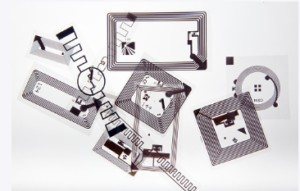Whether fixed or hand-held, RFID readers use electromagnetic fields to detect the radio signals of the tags. LF, HF and UHF readers can read multiple tags simultaneously and do not need line of sight.
 It enables warehouse staff to reconcile inventory orders against stock instantly. It also reduces shipping errors and picking mistakes.
It enables warehouse staff to reconcile inventory orders against stock instantly. It also reduces shipping errors and picking mistakes.
Detection
RFID readers have antennas that send and receive RF signals. Reader antennas convert electrical current into electromagnetic waves and transmit them to tag antennas, creating backscatter signals containing the tag’s data. There are a variety of RFID reader antennas, each optimized for the specific application and environment. The antennas are printed or etched with conductive ink, stamped with a specialized metallic coating, or vapour-deposited onto labels.
Unlike barcode scanners, RFID readers can take inventory without contact with items—even when they are several meters away. It enables them to scan items faster and eliminates the need for line-of-sight readings, which can reduce labour time. In addition, RFID systems can track the location of objects in real-time and alert workers when inventory is low or a product is out of stock.
An essential consideration for RFID reader applications is determining how far the system can scan. For some applications, only a few inches of distance may be needed to read a tag’s signal. For others, a more excellent range of coverage is required. RFID readers can be hand-held, mobile or fixed, each with specifications and benefits.
Hand-held RFID readers provide portability and convenience, allowing workers to scan objects or individuals with a simple wave of the device. Fixed RFID readers are placed at access points to automatically check tags entering or exiting a zone, such as a warehouse, office building or retail store. Depending on the reader, it may include a keypad for entering a PIN or supplementary information for high-level security applications.
An advantage of www.ramprfid.com RFID readers is its ability to work through metals. For example, a factory or warehouse may use it to automate goods reception processes by scanning container contents as they are loaded into trucks or conveyors. It may also be used to monitor the status of a container’s contents during transit, which helps to ensure that cargo is delivered on time and according to quality standards. RFID readers also allow locating individual products inside a container, a crucial feature for supply chain management.
Data Collection
Unlike barcode scanners that use lines of light to “read” a barcode’s black and white patterns, RFID readers send out electromagnetic waves that can detect the signal created by an active tag. When a tag’s signal is detected, the reader decodes it and sends it to a computer system. This information can then be integrated with other data in the database, enabling the RFID system to perform multiple functions simultaneously.
When a passive tag enters the range of a reader, it can harness the electromagnetic energy from the radio frequency signals to power its IC and start broadcasting a return report of its location to the antenna. Suppose the reader’s signal is strong enough. In that case, it can even activate a battery-assisted passive tag so that the title continues to transmit its information after it leaves the interrogation zone.
RFID tags can store much information, including the time and date they entered an interrogation zone, the serial number and other details associated with each item. This level of stock visibility reduces picking and shipping errors by allowing warehouse staff to correct them before things go out the door. It also makes inventory traceable throughout the supply chain by recording the time and date each item passed each RFID reading point.
There are several formats of RFID readers, and the choice depends on the application. For example, a hospital that uses RFID to track equipment and staff might choose a deterministic reader that reads each tag bit by bit rather than scanning all available frequencies within its bandwidth, which is frequency hopping. Choosing a deterministic reader can help prevent tag collision, which happens when two or more readers simultaneously pick up the same transmission from the same tagged object.